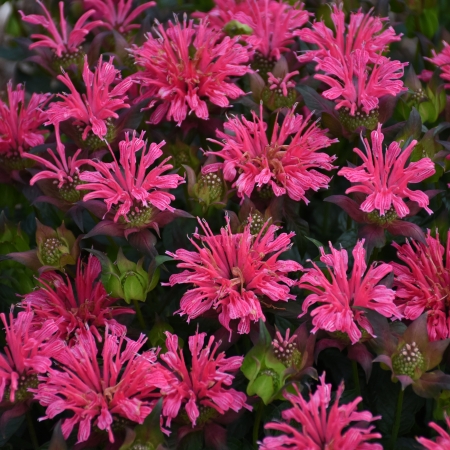Monarda (Bee Balm)
×
Color Name: Pardon My Rose
No room for the tall, bushy, traditional Bee Balm in your garden? Here is a compact selection that's easy to tuck into the front of your sunny border and combination containers. Reaching just a little over a foot tall at maturity, this compact selection forms a bushy, well-branched clump of medium green, semi-glossy foliage.
In midsummer, intense rose pink flowers sit just at the top of the foliage. Though the plant may be smaller, the flowers are the same size as taller selections, measuring a full 2½-3" across. They add a bright splash of color to the border in high summer.
This selection also offers good resistance to powdery mildew, a problem with many older Bee Balms. Just provide good air circulation, sunshine, and plenty of water and these plants will thrive!
Monarda is native to eastern North America, so it is easy to grow and it multiplies quickly. The flowers' sweet nectar attracts scores of hummingbirds, butterflies, and bees to the garden. The aromatic foliage smells like mint when crushed and is often used to flavor teas.
Growing Tips: Monarda can be found naturally along riverbanks and enjoys this rich, organic, moist soil. However, it will grow in average soil as well. Full sun is best, but light shade is tolerated. Plants tend to spread more quickly in the shade, however.
Most monardas multiply rapidly either by underground stems or self-sowing. Deadheading spent blooms will prolong the bloom time.
Powdery mildew is a common fungal problem with monarda. Some varieties are more resistant to it than others. To prevent this fungus from appearing, large clumps should be thinned out so that the air circulates freely around them. The soil should also be kept consistently moist; dry soil promotes powdery mildew.
Photo courtesy of Walters Garden, Inc.
No room for the tall, bushy, traditional Bee Balm in your garden? Here is a compact selection that's easy to tuck into the front of your sunny border and combination containers. Reaching just a little over a foot tall at maturity, this compact selection forms a bushy, well-branched clump of medium green, semi-glossy foliage.
In midsummer, intense rose pink flowers sit just at the top of the foliage. Though the plant may be smaller, the flowers are the same size as taller selections, measuring a full 2½-3" across. They add a bright splash of color to the border in high summer.
This selection also offers good resistance to powdery mildew, a problem with many older Bee Balms. Just provide good air circulation, sunshine, and plenty of water and these plants will thrive!
Monarda is native to eastern North America, so it is easy to grow and it multiplies quickly. The flowers' sweet nectar attracts scores of hummingbirds, butterflies, and bees to the garden. The aromatic foliage smells like mint when crushed and is often used to flavor teas.
Growing Tips: Monarda can be found naturally along riverbanks and enjoys this rich, organic, moist soil. However, it will grow in average soil as well. Full sun is best, but light shade is tolerated. Plants tend to spread more quickly in the shade, however.
Most monardas multiply rapidly either by underground stems or self-sowing. Deadheading spent blooms will prolong the bloom time.
Powdery mildew is a common fungal problem with monarda. Some varieties are more resistant to it than others. To prevent this fungus from appearing, large clumps should be thinned out so that the air circulates freely around them. The soil should also be kept consistently moist; dry soil promotes powdery mildew.
Photo courtesy of Walters Garden, Inc.
|
Flower Color: Pink shades Foliage Color: Green shades
Height: 14 to 18 Inches Spread: 22 to 28 Inches Hardy in Zone: 4, 5, 6 |
Blooms: Late Summer Mid-Summer
Foliage Season: All Season |
Growth Rate |
Medium
|
Attributes |
Fragrant Native Border Cut Flower or Foilage Easy to Grow Landscapes Mass Planting
|









